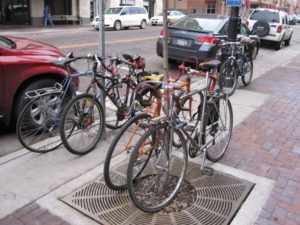Transformative changes are taking place in the Lincoln Park neighborhood.

A major redevelopment of the old Clyde Iron industrial complex was just completed. A new Western middle school is rising on the hillside. A segment of the Cross-City trail will be winding through this neighborhood in the next few years as it spans the city from east to west along the waterfront.
Here at the MIC, we see these exciting new community-oriented developments and start to think about…access, connectivity and land use.
We’re kind of geeky that way. Let me explain.
Access is about making sure that people, who have different mobility options and who need or want to use these facilities, can get to them easily and safely.
Connectivity is about making sure that usable and intuitive transportation links exist between the new developments and other destinations. At the base of this this neighborhood, popular destinations would include Wade Stadium, Wheeler Field and Harrison Park. And along the top of the ridgeline are Skyline Parkway and the Superior Hiking Trail.
Complicating the situation, the land uses for these facilities are distinctly at odds with each other.
The middle school is located on the edge of a traditional residential neighborhood that is easy to walk through, with square blocks, houses close together and minimal, slow moving traffic. It can actually be characterized as a semi-rural area, with few sidewalks and narrow streets, many of which dead end into large open spaces.
The Clyde Iron complex, in contrast, which also houses a Boys and Girls Club, indoor athletic fields, year-round ice rink, and in the future a nearby Duluth Children’s Museum—is located in an established industrial area, where a significant level of pedestrian traffic was not anticipated.
Last but not least is the huge barrier of the railroad tracks that run between the school and the Wheeler Field park space and the Denfeld neighborhood immediately west of the school.
So, a number of our current studies are taking a look at how people move around this neighborhood in light of the new developments. Creating a walking corridor between these facilities is a key transportation piece for this neighborhood.
The Lincoln Park Pedestrian Corridor Plan is focused on creating a walking route up and down the hill from the middle school to the Clyde Iron complex.
An upcoming Safe Routes to School site assessment will further examine the school and walking and bicycling routes to the middle school to the surrounding neighborhoods.
And a larger neighborhood wide transportation study, the Lincoln Park Multimodal Transportation Assessment will build off of the other 2 studies and focus on all modes of travel in the neighborhood.
Lots of work is ahead. We’ll keep you posted.
Photo credit: Scott Byykkonen
Co-writing credit: Rondi Watson







